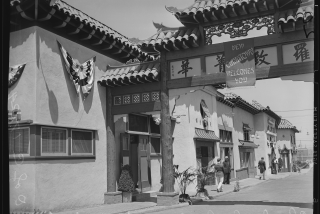Conflict, missionaries and missions in three SoCal history books
To live in Southern California is to feel unmoored from history. Throughout the 20th century, assorted city and state officials and developers routinely destroyed and obliterated landmarks and old neighborhoods, creating the illusion of Los Angeles and its suburbs as a perpetually new place.
But the writing of Southern California history has entered a kind of golden age in recent years. My own personal favorites include William Estrada’s excellent and often enthralling 2008 “The Los Angeles Plaza,” and William Deverell’s ground-breaking 2005 “Whitewashed Adobe: The Rise of Los Angeles and the Remaking of its Mexican Past.”
As 2013 rounds to a close, three more books of L.A. history have reached my desk.
“Before L.A.: Race, Space and Municipal Power in Los Angeles, 1781-1894,” by David Samuel Torres-Rouff, builds upon the work of Deverell and Estrada and other recent histories with a painstaking reconstruction of the cultural conflicts over the city’s growth, from its beginnings as a tiny outpost of the Spanish empire to the first real estate boom that made it a major U.S. city.
In 1850, just after the Mexican War, Los Angeles had a mere 1,610 inhabitants. By 1900, it had surpassed 100,000. What transpired in those 50 years was an incredibly complex drama involving old “Californio” families who traced their roots to the early Spanish settlers; Anglo-Saxon migrants from the East and Midwest of the U.S.; Asian immigrants who built a Chinatown that was seen by outsiders as a den of iniquity; and more recently arrived laboring people from northern Mexico who settled in a neighborhood just north of L.A.’s central Plaza called Sonoratown.
Torres-Rouff is a historian at UC Merced and “Before L.A.” is an academic work, concerned with, among other things, the “mutually constitutive relationship between race and space that shaped nineteenth-century Los Angeles.” But it provides much rich detail to engage the general reader of L.A. history. In “Before L.A.” we meet arsonists, see 19th century riots, and are presented with maps labeled in their day with euphemisms such as “Hos. Of I.F.,” meaning “House of Ill Fame,” or brothel.
Gregory Orfalea’s “Journey to the Sun: Junipero Serra’s Dream and the Founding of California” is a book in short supply in California literature: a popular, highly readable history of an important historical figure. In “Journey to the Sun,” the founder of California’s Spanish missions is a romantic, pious and ambitious figure.
“There was probably never a more bookish conquistador than Junipero Serra, and perhaps it’s appropriate that he has been called ‘the last of the conquistadors,’” Orfalea writes. “Not only would he be the last Spaniard to enter the untouched territories of the native peoples of North America, he would take to them the mind-set of someone used to speaking with young people about great theological, philosophical, and historical topics, who himself was college educated and a college professor.”
Orfalea’s book is polished and professional. Another book that isn’t nearly as rigorous in its treatment of California history is Robert A. Bellezza’s “Missions of Los Angeles,” the latest in the “Images of America” series from Arcadia Publishing. The title is a misnomer twice over, since the book contains images of churches that are not missions (like La Placita in downtown Los Angeles) in addition to images of a mission that is far outside Los Angeles, in San Juan Capistrano.
Bellezza does a wonderful job of collecting a variety of evocative images, most of which are from two local archives, the Los Angeles Public Library and the Southwest Museum. We see images of the missions in a state of decay, with crumbling adobe and brick walls at the beginning of the 20th century. Unfortunately, the photographs are often not dated, leaving the reader to guess at their historical context.
But “Missions of Los Angeles” offers a good visual accompaniment to any of the many books I’ve mentioned here, works that illuminate the rich history of a region that doesn’t seem to have one.
ALSO:
Ned Vizzini: writers and friends pay tribute
‘A Dreadful Deceit’ argues against a ‘racial’ past
Free houses for writers: Inside the Write a House project
More to Read
Sign up for our Book Club newsletter
Get the latest news, events and more from the Los Angeles Times Book Club, and help us get L.A. reading and talking.
You may occasionally receive promotional content from the Los Angeles Times.







